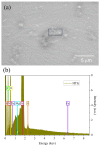Magnetic Analysis of MgFe Hydrotalcites as Powder and Dispersed in Thin Films within a Keratin Matrix
- PMID: 37513040
- PMCID: PMC10384693
- DOI: 10.3390/nano13142029
Magnetic Analysis of MgFe Hydrotalcites as Powder and Dispersed in Thin Films within a Keratin Matrix
Abstract
Hydrotalcites (HTlcs) are a class of nanostructured layered materials that may be employed in a variety of applications, from green to bio technologies. In this paper, we report an investigation on HTlcs made of Mg and Fe, recently employed to improve the growth in vitro of osteoblasts within a keratin sponge. We carried out an analysis of powder materials and of HTlcs dispersed in keratin and spin-coated on a Si/SiO2 substrate at different temperatures. A magnetic study of the powders was carried out with a Quantum Design Physical Property Measurement System equipped with a Vibrating Sample Magnetometer. The data gathered prove that these HTlcs are fully paramagnetic, and keratin showed a very small magnetic response. Optical and Atomic Force Microscopy analyses of the thin films provide a detailed picture of clusters randomly dispersed in the films with various dimensions. The magnetic properties of these films were characterized using the Nano Magneto Optical Kerr Effect (NanoMOKE) down to 7.5 K. The data collected show that the local magnetic properties can be mapped with a micrometric resolution distinguishing HTlc regions from keratin ones. This approach opens new perspectives in the characterization of these composite materials.
Keywords: Keratin; NanoMOKE; PPMS-VSM; hydrotalcites; magnetic properties; thin films.
Conflict of interest statement
The authors declare no conflict of interest.
Figures












References
-
- Bellezza F., Cipiciani A., Costantino U., Nocchetti M., Posati T. Hydrotalcite-like Nanocrystals from Water-in-Oil Microemulsions. Eur. J. Inorg. Chem. 2009;18:2603–2611. doi: 10.1002/ejic.200801114. - DOI
-
- Leroux F., Taviot-Guého C. Fine tuning between organic and inorganic host structure: New trends in layered double hydroxide hybrid assemblies. J. Mater. Chem. 2005;15:3628–3642. doi: 10.1039/B505014F. - DOI
-
- Oh J.-M., Biswick T.T., Choy J.-H. Layered nanomaterials for green materials. J. Mater. Chem. 2009;19:2553–2563. doi: 10.1039/B819094A. - DOI
-
- Trujillano R., Labajos F.M., Rives V. Hydrotalcites, a rapid survey on the very recent synthesis and applications procedures. Appl. Clay Sci. 2023;238:106927. doi: 10.1016/j.clay.2023.106927. - DOI
LinkOut - more resources
Full Text Sources

